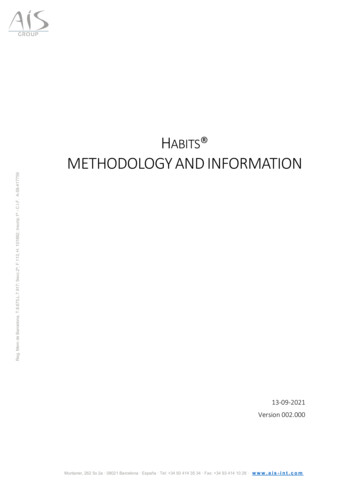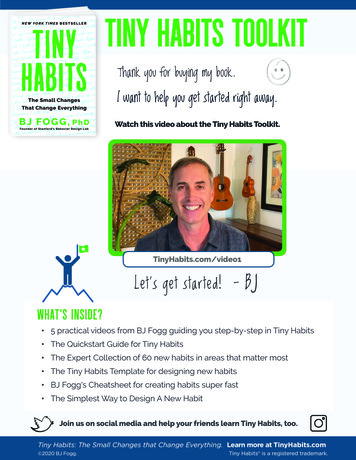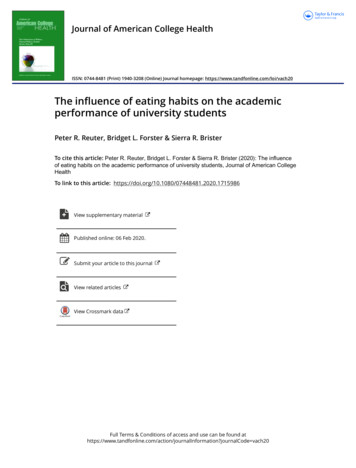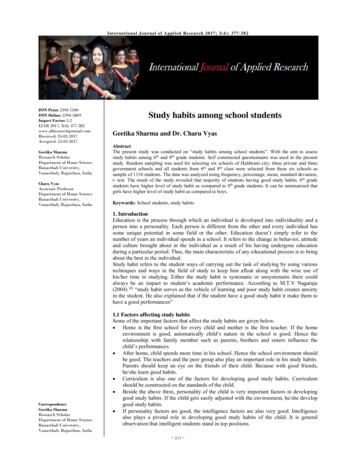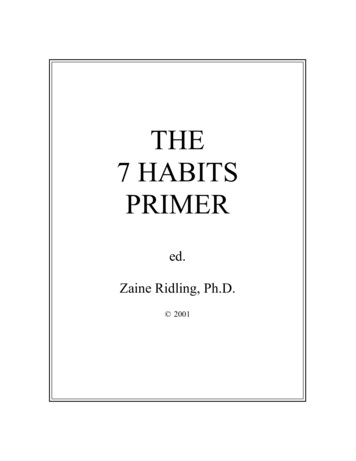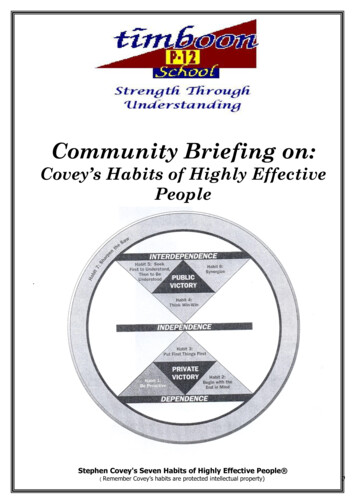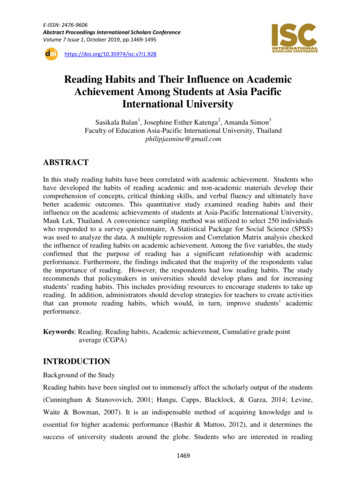
Transcription
E-ISSN: 2476-9606Abstract Proceedings International Scholars ConferenceVolume 7 Issue 1, October 2019, eading Habits and Their Influence on AcademicAchievement Among Students at Asia PacificInternational UniversitySasikala Balan1, Josephine Esther Katenga2, Amanda Simon3Faculty of Education Asia-Pacific International University, Thailandphilipjasmine@gmail.comABSTRACTIn this study reading habits have been correlated with academic achievement. Students whohave developed the habits of reading academic and non-academic materials develop theircomprehension of concepts, critical thinking skills, and verbal fluency and ultimately havebetter academic outcomes. This quantitative study examined reading habits and theirinfluence on the academic achievements of students at Asia-Pacific International University,Mauk Lek, Thailand. A convenience sampling method was utilized to select 250 individualswho responded to a survey questionnaire, A Statistical Package for Social Science (SPSS)was used to analyze the data. A multiple regression and Correlation Matrix analysis checkedthe influence of reading habits on academic achievement. Among the five variables, the studyconfirmed that the purpose of reading has a significant relationship with academicperformance. Furthermore, the findings indicated that the majority of the respondents valuethe importance of reading. However, the respondents had low reading habits. The studyrecommends that policymakers in universities should develop plans and for increasingstudents‘ reading habits. This includes providing resources to encourage students to take upreading. In addition, administrators should develop strategies for teachers to create activitiesthat can promote reading habits, which would, in turn, improve students‘ academicperformance.Keywords: Reading. Reading habits, Academic achievement, Cumulative grade pointaverage (CGPA)INTRODUCTIONBackground of the StudyReading habits have been singled out to immensely affect the scholarly output of the students(Cunningham & Stanovovich, 2001; Hangu, Capps, Blacklock, & Garza, 2014; Levine,Waite & Bowman, 2007). It is an indispensable method of acquiring knowledge and isessential for higher academic performance (Bashir & Mattoo, 2012), and it determines thesuccess of university students around the globe. Students who are interested in reading1469
Abstract Proceedings International Scholars Conference, Volume 7 Issue 1, October 2019, pp. 1469-1495including non-academic literature, increase their emotional and academic intelligence(Okwilagwe, 1998). If students possess good reading habits, they can increase their criticalreasoning skills and ultimately have better academic outcomes. In addition, even the readingof non-academic books enhances students‘ language skills.However, Asagwara (2001) indicates that weak reading habits negatively affect students‘comprehension, thus affecting their performance and advancement. Even capable studentswho reduce their reading underperform academically (Levine, Waite & Bowman, 2007).Nevertheless, some students who have under-developed reading skills have shown markedprogress after participating in extensive reading projects (Anderson. Wilson & Fielding(1988).Unfortunately, leisure time preferences have become increasingly bent towards technologyand social media instead of reading (Obaidullah & Rahman, 2018). The use of, YouTube,Facebook and other online websites make it easier for students to watch videos and otheronline programs and they ignore reading (Obaidullah & Rahman, 2018; Palani, 2012).;Palani, 2012). Consequently, an increasing number of students have a negative attitudetowards academic reading. It is because of these reasons that the number of students who readoutside the classroom has declined at an alarming rate.Home environments and cross-cultural issues also affect reading habits (Ameyaw, Anto,2017; Chen, Yang, 2014; Heath et al., 2014). Those who have read from the time they wereyoung, excel in reading and are more knowledgeable (Cunningham & Stanovich, 2001;Peaerson, 2013) while those who come from low-income families or cultures where readingis not introduced or emphasized, display very poor reading skills (Snow, Burns & Griffin,1998). In some Ghanaian village home environments where there is a lack of readingresources and where children are expected to do chores at home instead of reading, it isdifficult for them to form reading habits ( Ameyaw & Anto, 2018; Yamoah, 2015), and thisimpacts their college reading habits.Some Southeast Asia countries, the governments are struggling to raise the reading level.Thailand is no different from schools in Southeast Asia. It has one of the worst readingrecords. Reading has not been emphasized beyond textbooks, even at the university level.However, the ASEA Libraries have taken up the battle to promote reading to children(Choomthong, 2014; Sangkaeo, 1999). In other countries like Indonesia, teacher's efforts toincrease reading habits are paying off. However, the level of reading is still unsatisfactory1470
Balan, Katenga & Simon, Reading Habits and Their (Poedjiastutie., 2018) These issues necessitates the investigation of reading habits and itseffect on academic performance.Problem Statement and Purpose of the StudyLiterature shows that the distractions from technology and social media have caused thedecline of reading habits among college students and has increased students‘ lack of passionfor reading (Briggs, 1987; Palani, 2012). In addition, some students do not acquire readinghabits because of their specific home environments that are affected by poverty, traditionalbeliefs, and practices. Students from these environments who have little experience in readingfind it hard to excel in college (Ameyaw & Anto, 2018; Yamoah, 2015). The QECD (2014)survey in Thailand showed that Thai students performed poorly on PISA. The test alsorevealed that students‘ reading ability affected their academic achievement. This research,therefore, aimed at examining the influence of reading habits on academic achievementamong students at Asia Pacific International University, Thailand. This study also focused oninvestigating the relationship between reading habits and academic achievement. Thefollowing were the research questions:1. What are the reading habits of students at Asia Pacific International University?2. What is the level of students‘ academic achievement?3. Is there a relationship between reading habits and academic achievement?LITERATURE REVIEWBond Tinker, Wasso, and Wasson (1994) claim that reading is a process in which individualscan distinguish the symbols from the reading patterns. Therefore, the reader can understandwhat is read and later remember the passages that he enjoyed. However, Chettri & Rout(2013) understood reading as an optional step taken by people to critique various topicsdiscussed in a passage and indicated that in learning, reading is the medium that helps peopleto gain a deeper understanding of the world around them.Okwilagwe‘s (1998) definition of reading includes meaningful interpretation of words,phrases, and sentences. He states that reading requires different types of critical thinking suchas analyzing, creating, imagining, evaluating, and problem-solving. The process of readingshould also include understanding, questioning, interpreting, predicting, defining, the words,and the writer‘s meaning of the passage. This definition suggests that reading developscognitive skills (Collins, Brown, & Newman 1998; Kidd & Castano, 2013; Whitten, Labby,1471
Abstract Proceedings International Scholars Conference, Volume 7 Issue 1, October 2019, pp. 1469-1495& Sullivan, 2016.). This definition corresponds with the conceptual understanding of thisstudy.Reading as a HabitThe activity of reading is considered a habit when it is frequently carried out. In other words,reading is measured in terms of materials read and the period spent on reading (Wagner,2002). According to Chettri and Rout (2013), reading habits are ―the number of materialsbeing read, the frequency of reading as well and the average time spent on reading‖ (p.13).Similarly, Wagner et al. (2002) describe reading habits as the volume and the extent to whichmaterials learned, and the maximum number of hours spent reviewing and reflecting on theconcepts.In an academic context, reading assists the reader to increase their knowledge and wisdom. Ithelps students to retain information and brings significant changes in a person's social,spiritual, and economic status. The positive outcomes of effective reading habits can be seenwhen a student‘s comprehension expands (Okwilagwe, 1998). Therefore, for this study,reading habits are defined as purposely planning and spending time to read for leisure andacademic material until a person forms an appetite for reading.Academic AchievementAcademic achievement measures how successful students are and refers to the attainment ofones‘ scholastic goals. Crow and Crow (1996), defined academic achievement in terms ofskill acquisition: ―Academic achievement is reflected by the extent to which a person hasacquired the skill of knowledge through the training imparted to him.‖ (p. 345). However,academic achievement is measured after students take assessments tests by ratings decidedupon and applied by the school. Achievement levels are often measured through a GradePoint Average (GPA) of the students‘ score.Factors That Affect Academic AchievementApart from reading habits, other variables affect academic success. These factors include,instructional strategies and quality of teaching (Blazar, 2015; Ganyaupfu, 2013), peer support(Smithikrai, et al., 2018), family background (Mushtaq and Khan, 2012) and class attendance,(Hocking, 2008).1472
Balan, Katenga & Simon, Reading Habits and Their Tynjälä, Välimaa and Sarja (1998) observed that student-centered learning environments areessential for producing better learning outcomes than the traditional teacher-centeredinstruction models. Smithikrai, et al. (2018) after studying 802 Thai undergraduate universitystudents, discovered that students‘ peer support, satisfaction with the quality of teaching andmost importantly, the purpose for obtaining an education played a role in students‘ eagernessand effort to perform well in their academic studies. A study by Mushtaq and Khan (2012)conducted at private colleges in Pakistan revealed essential factors that affect the students‘academic performance, these included: family background (economic status, parents level ofeducation and parental guidance) types of communication, family stress, and learningfacilities. Class attendance is also critical to academic achievement (Hocking, 2008). Aden,Yahye, Dahir, 2013 studied the effects of 100 Somalian university student‘s attendancerecords and found a positive relationship between students‘ attendance and academicachievement.Other factors affecting academic achievement include race and gender, (Bignold, 2003;Hansen, 2000)), social-economic status (Adams, 1996; Walters & Soyibo,1998), students‘self-regulation (Adunola, 2011). the students‘ level of intelligence (Naderi, et al., 2009) andclassroom attendance (Aden, Yahye, & Dahir, 2013). Muhdin (2016) also revealed morevariables that influence academic outcomes, such as students‘ sleeping time, universityentrance exam score, and the family financial situation.The Effect of Reading Habits on Academic AchievementLiterature posits that academic achievement is based on the students‘ development of readinghabits (Annamalai & Muniandy, 2013). A study conducted by Horbec‘s (2012) showed astrong relationship between reading habits and academic achievement. The reading habitssignificantly assists the students in their learning process and enhances their academicoutcomes (Fatiloro, Oyekoa, & Hameed, 2017; Kidd & Castano, 2013; Whitten, Labby, &Sullivan, 2016). The importance of reading habits surpasses the use of object lessons,blackboards, maps, pictures, and, even reading digital texts. Lessons taught through reading,eventually, help students to fix those lessons into the memory (Singer & Alexander, 2017).It is a proven fact that recreational reading is a catalyst for developing grammar andvocabulary (Krashen 2004, 2009; Krashen & Williams, 2012). Reading for pleasure has aninfluence on the development and understanding of concepts, verbal fluency, comprehension,eloquence, vivid thinking, and academic achievements, (Cunningham and Stanovich, 1998;1473
Abstract Proceedings International Scholars Conference, Volume 7 Issue 1, October 2019, pp. 1469-1495Whitten, Labby, & Sullivan, 2016). On the other hand, lack of reading habits results in verypoor grades. A study of 227 preservice teachers who had completed three years of theirbachelors‘ degree had poor reading comprehension because they did not like reading and didnot appreciate assignments. Those who enjoyed reading had better scores (Benevides &Peterson, 2010).Reading Habits in South East AsiaThe Southeast Asian countries have difficulties raising the reading habits of their students.These governments are trying to raise the reading level of their students by promotinglibraries (Poedjiastutie, 2018). A study conducted in Tangerang City in Indonesia showed thatfew people were in the habit of reading. The study revealed that the family also played animportant role in academic performance when they provided their children with anenvironment for reading (Andayani & Maryam, 2018). On the other hand, 96.6% of studentsin Malaysia participated in academic reading because they looked for information that wouldhelp them with project information. Even though student read other non-fiction books, theydo so to work on assignments.Thailand is no different from schools in southeast Asia. It has one of the worst rendingrecords Thailand was a hub of literacy in the 1890s. Male children were taught to read at alevel comparable to or above that of Europe children because of the Buddhist culture (AsiaCorrespondent, 2012). Unfortunately, Thailand has become a culture that deemphasizesreading but believes in learning from the teachers and course material (OECD, 2014) A studyby OECD (2014) revealed that Thai people do not view reading as a required activity. Thestudents had low reading ability which affected their academic achievement on the PISA test(OECD, 2014).A survey conducted by Peter J. Foley‘s of the Southeastern Asian countries (Singapore,Malaysia, Thailand, and Japan) reported in the Asian Correspondent (2012) revealed thatThailand had the lowest reading rate. Participants in Thailand read five books a year; whilethe Japanese had the highest number amongst the Southeastern Asian countries. Theiraverage was reading 50 books a year. Perhaps one of the reasons is the consumption ofmedia. A report by the National Statistical Office (2008) showed that Thais readapproximately 39 minutes a day. This report drove the government to establish on April 2 theReading Day and organized campaigns that promoted reading. This included distributing1474
Balan, Katenga & Simon, Reading Habits and Their books to children, selling reasonably priced books and censoring harmful books and media(Ngamwittayaphong, 2011).Factors That Influence Reading HabitsSeveral factors influence reading habits. Research shows that reading habits are related toage, gender, marital status, educational background and occupation, and parents educationalbackground (Tor-Akwer & Chorun, 2014). A study of 410 college students in Indiaconducted by Allahi and Khandai (2015) presented finding that showed female collegestudents‘ reading habits resulted in better academic outcomes because their reading habitswere higher than that of males.In addition to demographics, advancement in technology has brought about an influx ofinformation and widespread use of media. Gunasekara (2002) discovered that Srilankanstudents spent much of their time online surfing the internet and continuously chatting,watching media and, neglected to study. They only crammed for their final exam. Liu(2000), in another study, observed that the students‘ first preference was to watch programson television during their free time instead of reading. An international survey (Books AidInternational, 2003) revealed that the reading capacity of tertiary students in the UnitedKingdom has decreased because of YouTube and sharing online content. Approximately halfof the students read, and that they only do so at the time of the final examination.It has been established that students‘ attitude to reading promotes or hinders the developmentof reading habits. Briggs (1987) argues that children‘s negative attitude to reading reducestheir motivation to read. In a study of college teachers‘ in training, conducted by Applepgate,et all. (2014), it was discovered that most of the students had little enthusiasm for reading.Only 48.9% of these students were interested in reading. In another study by Bulgurcuoglu(2016), female pre-service teachers had a positive attitude toward reading and had betteracademic results.A lot of students are lazy and have no interest in reading academic literature (Owusu-Acheaw& Larson, 2014). Some students have learned to read in their homes, but as they get older andget into other hobbies, their attitude changes and they stop reading. Students who stoppedregular reading in elementary or secondary school become slow learners when they go tocollege (Akabuike, & Asika, 2012).The family background and home environment can also affect reading habits. Students whonever learned to read at home because they lacked reading materials and or because of1475
Abstract Proceedings International Scholars Conference, Volume 7 Issue 1, October 2019, pp. 1469-1495parents‘ level of education, have difficulties developing reading habits (Ameyaw & Anto,2018; Yamoah, 2015). A study of 395 college students majoring in education (Capps &Huang, 2015) reported that their parents never read to them when they were young (Capps &Huang, 2015), and this affected their reading ability. In some Ghanaian villages povertydictates whether students are interested in reading. The lack of reading materials or thedistractions in the home environment makes it difficult for students to concentrate on reading(Acheaw, 2004: Ameyaw & Anto, 2018; Yamoah, 2015).Language skills of international students can be the reason for poor reading habits. Alghail &Mahfoodh (2016) observed that international college students had difficulties in readingacademic papers. The students found ―taking brief and relevant notes; using own words innote-taking; working out the meanings of difficult words, and identifying supportingideas/examples‖ (p. 379) daunting. These authors reasoned that students had readingproblems and low English language skills because of little experience with academic readingmaterials.The Development of Reading HabitsReading habits can be nurtured and cultivated (Bahruddin, Hasnol, Ramsi & Kadir, 2015)through the proper guidance of parents, teachers, and others (Clark and Rumbold, 2006).Studies do confirm that children who are taught early to read at home will carry the habit forlife (Cunningham & Stanovich, 2001; Strauss, 2009). White (2002) explains that reading is auseful component to be imprinted in the mind of the young, and the art of reading should becarried out throughout their lives. She insisted that parents should not neglect the training ofchildren to read and write. A study conducted by Benevides & Peterson (2010) revealed thatpre-service teachers who were successful had learned reading while young. Their parents hadencouraged them to enjoy reading at the library.Some researchers have argued that when students invest time and enjoy the reading activity,they become competent in mastering the language, (Reyhene, 1998). Others believe that theactivity of reading is reflected as a habit when it is purposely focused on a specific goal(Chettri, & Rout, 2013). Over time, the reader of books understands and appreciates thecentral themes or purposes for which the books were written and broadened the conceptualunderstanding of ideas which can be transferred and articulated to form the individual‘sperception of life (Reyhene, 1998; Chettri & Rout 2013).1476
Balan, Katenga & Simon, Reading Habits and Their Consequently, developing a reading habit requires daily repetition (Méndez 2018). Thisrepetition helps in mental development as a person learns creativity and critical thinking(Tung & Chang, 2009). In a specific study (Linzer et al.,1988), 44 medical interns were,given a journal or seminar series to read. The more sessions the interns attended, the moreknowledge they gained. Unfortunately, if the students did not have the materials to read ordid not live close to libraries that had inadequate reading materials, they were unable to formthe reading habit (Ogunrombi, 1995).Conceptual FrameworkThe figure below presents the conceptual framework for the study which investigated the―Reading Habits and their influence on Academic Achievement among students at AIU,Thailand. From the discussion above, it is apparent reading habits have a positive or negativeeffect on academic achievement. The conceptual framework shows five dependent variables,which define reading habits and their relationship to academic achievement.1. Reading Attitude. A persons' attitude determines whether the student can develop areading habit Some students spend most of their time doing video games or watchingvideos. This type of behavior results in having a poor attitude toward reading(Martinez, Aricak & Jewell; 2008; Tunde–Awe, 2014).2. Reading initiative abilities This pertains to whether a student has the self-efficacy tomake goals for reading.3. Type of materials one reads. Non-academic reading materials include newspapers,novels, etc. Academic reading includes journals and textbooks. Not all readingmaterials promote academic success.4. Purpose of reading. Reading for the reader‘s pleasure, reading for learning andunderstanding and reading for educational purposes.5. c) Time spent on reading. Duration of reading to form a reading habit. The personhas to spend time reading good books and materials. good books and academicmaterials.1477
Abstract Proceedings International Scholars Conference, Volume 7 Issue 1, October 2019, pp. 1469-1495Reading AttitudeReading FrequencySTUDENT’S ACADEMICMaterials readACHIEVEMENTPurpose of readingTime spent on readingFigure 1. Conceptual Framework on Reading HabitsMETHODSResearch DesignThis study used a quantitative research design that allowed the researcher to find informationby gathering numerical data, which was then analyzed and provides accurate and reliablefindings. (Leedy 1993; Creswell, 2003). Aliaga and Gunderson (2002) defined quantitativeresearch as an investigation of social phenomena that can be analyzed with the help ofmathematically based approaches such as statistics. Using Quantitative research processesenables researchers to collect and analyze data from a large sample of the population in ashort period. In addition, it provides descriptive analysis which establishes relationshipsbetween variables. This study adopted a quantitative descriptive research design using asurvey research method which is considered as one of the most effective ways to gatherdescriptive data.Population and SampleParticipants for this study were undergraduate students at Asia-Pacific InternationalUniversity (AIU), Thailand. A convenience sampling method was used to sample thepopulation. Dörnyei (2007) stated that convenience sampling can be used if the members ofthe target population meet specific criteria. This sampling method is used because of1478
Balan, Katenga & Simon, Reading Habits and Their proximity, availability and willingness to participants.However, Mackey and Gass (2005)points out that bias is the main disadvantage of convenience sampling.In using the above sampling method, 250 students participated in the study. The sampleincluded students enrolled in various academic disciplines, namely, Business Administration,Arts and Humanities, Religious Studies, Education, English as Second Language (ESL), andScience. These students come from thirty-eight different countries.Data Collection InstrumentThe survey questionnaire was designed to elicit vital information from the students. Studentswere to indicate on the 5-point Likert scale their reading attitude, reading frequency,materials read, the purpose of their reading, and time spent on reading. Data collection alsoincluded demographic information such as gender, age, nationality, faculty, current academicyear, and GPA in that semester.The questionnaire had five sections. Part A dealt with demographics; Part B had questions onreading attitude, Part C examined reading frequency, Part D inquired about materials, Part Ehad a list of items on the purpose of reading, Part F students reported about how much timethey spent on reading.Table 1. Variable descriptive statistics and reliability estimates (n 250)VariableReading attitudeReading frequencyReading materialsReading purposesTime .256.598.696.921.742Cronbach‘s (1951) Alpha was computed to determine the reliability of the instrument. TheCronbach alpha for reading attitude, 5-item scale, was 0.256 and the alpha Cronbach forreading frequency 6-item scale, was 0.598, followed by for material read, 7- item scale, was.696 and purpose of reading 16-point scale, was 921. These scores indicated that the items onthe questionnaire were reliable for the actual research. Refer to Table 1.The survey questionnaire for this study was adopted from Oriogu and Subair (2017), who hadpilot-tested it for validity. Dr. Mantiri, a lecturer at AIU who was an expert in the area ofquestionnaire validity, checked the instrument for validity, which included correctness and1479
Abstract Proceedings International Scholars Conference, Volume 7 Issue 1, October 2019, pp. 1469-1495appropriateness of the items on the Likert scale. He concluded that the items were reasonablemeasures for checking the reading habits of students. A copy of the questionnaire was alsosent to the research course advisers for crosschecking and validation.Procedure for Data CollectionPermission was given by Asia Pacific International University (AIU) Institution ReviewBoard to collect data. Courtesy visits to the AIU dorms and offices were undertaken toinform the deans and teachers about the study and to introduce the researcher. Students weregiven the survey when they agreed to participate in the survey and the purpose of the studywas explained to them. The researcher collected the completed surveys on the same day. Therespondents took approximately 15 minutes to respond to the questions and fill the survey.Data AnalysisThe data were organized according to research questions and research objectives beforeanalyzing. The particulars were tabulated and analyzed using descriptive statistics, namely;frequency counts, percentages, mean, and standard deviation to describe the informationreceived from the participants. Multiple regression and correlation matrix analysis methodswere used to examine how reading affected academic achievement. The statistics weregenerated using the Statistical Package for Social Sciences (SPSS). The information was laterpresented using tables for better understanding and analysis. From the analysis of multipleregression, the accepted rule of the hypothesis was P 0.05. The mean interpreted as follows: 1.5–Strongly Disagree,1.5-2.4-Disagree2.5-3.4-Neutral3.5-4.4-1 4.5Agree- Strongly AgreeRESULTSThe analysis included descriptive statistics such as frequency counts, simple percentage,mean, standard deviation. Other analysis included multiple regression. The results arepresented under the following headings: Demography of Respondents, Reading Attitude,Reading Frequency, Materials Read, Purpose of reading, Time spent on reading.1480
Balan, Katenga & Simon, Reading Habits and Their Demography of RespondentsDemographic data collected included gender, the age of respondents, nationality, faculty theybelong to, and the current academic level in the university.Table 2. 3.217-2021-2526-30 6.410.822.81.62.8106635042.425.220.0AgeFacultyArts & HumanitiesScienceESLEducation & PsychologyReligious StudiesBusinessNursingInformation TechnologyAcademic LevelFreshmanSophomoreJuniorTable 2 shows the distribution of the respondents by gender, age, faculty, and academic level.It revealed that the majority of the students who participated in study 142 or 56.8% weremale, while 108 or 43.2% were female.Respondents distribution by age shows that most of the students 48.4% who took part in thestudy were between 21-25 years and 38.0 % were between 17-20 years while only 11.6%were in the range between 26-30 years. This result displays that 2% of Asia PacificInternational University students who took part in the survey are slightly above 30 years.The distribution of respondents by Faculty reveals that 66 respondents which represent 26.4% were from the faculty of Education and Psychology accounting for the majority of studentswho participated in the study. There were 57 respondents from the Faculty of Business,which accounts for 22.8%, and 53 respondents representing 21.2 from the faculty of Arts andHumanities. From the faculty of Religious Studies and Science, there were 27 respondents1481
Abstract Proceedings International Scholars Conference, Volume 7 Issue 1, October 2019, pp. 1469-1495representing 10.8% for each of these disciplines. The faculty of ESL had only ninerespondents, which represent 3.6 % while there were seven respondents f
The Effect of Reading Habits on Academic Achievement Literature posits that academic achievement is based on the students‘ development of reading habits (Annamalai & Muniandy, 2013). A study conducted by Horbec‘s (2012) showed a strong relationship between reading habits and


